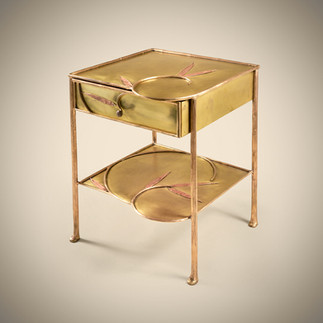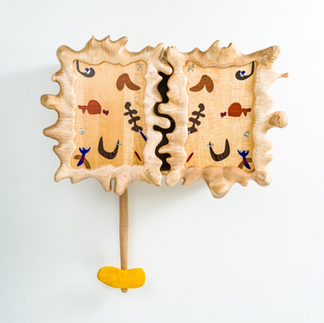A Conversation with Catherine Futter
- jennifer7795
- Oct 14, 2024
- 4 min read
Updated: Oct 16, 2024
Catherine Futter, Senior Curator of Decorative Arts and Director of Curatorial Affairs at the Brooklyn Museum, has curated a number of permanent-collection installations of European and American art and design, as well as numerous exhibitions on these subjects. Her recent endeavor, American Art Deco: Designing for the People, 1918-1939, had a four-venue national tour. This year, Catherine graces our Honorary Committee, and we took the opportunity to ask her some rapid-fire questions about her go-to NYC spots for creative inspiration, the best design advice she has received and would give to an entry-level collector, and more.
Art + Design Favorites

What exhibitors are you excited to see at the fair?
So many great galleries showing designers I am not aware of.
What’s your favorite piece of art/design in your own home or collection?
I have a lot of favorite pieces, and my favorites change all the time. I am particularly drawn to designers who are pushing the boundaries of materials and processes. I have a Joris Laarman jigsaw chair and a Chris Schank chair that are startling, dramatic and elegant. But I also love the clean lines of mid-century Scandinavian design.
If you were designing your dream home, which pieces would you choose?
My “dream house” is a modern, with floor to ceiling windows looking out over a rocky shoreline on the ocean. Therefore, my design choices were contemporary but based on the natural world.
Who is your favorite artist to collect?
That changes all the time. My sister and I collect together (two apartments, so two spaces to fill with art). We have been collecting a number of artists who work in textiles (which is a problem with light, but also gives us the opportunity to rotate works of art). Our travels have introduced us to artists around the world.
What’s your go-to NYC spot for creative inspiration?
Galleries and museums—every day I am not working, I try to see art—but I also work in a museum, so I can see art every day of the week. On the walk to my office in the museum, I see amazing works from the Brooklyn Museum’s Asian Art Collection. I try to see as many different kinds of art as possible. I am rather insatiable.
What’s your favorite NYC museum?
What’s your favorite NYC building?
Hard question! Probably the Woolworth Building; but there are plenty of more modern buildings that give me joy.
How would you describe your own style when it comes to interior design or decorating?
My style is eclectic with a mix of Scandinavian and American mid-century modern and contemporary furniture, with a big dose of American studio pottery. I love ceramics as a medium.
What is your most recent acquisition?
Two Ghosts by Si Lewen from around 2008.
Lifestyle
What was your introduction to design?
Although I was already an admirer of late-19th century American and the English Aesthetic Movement and Vienna Secession design, it was the early 1990s, when I worked at the Minneapolis Institute of Arts (MIA). I had the pleasure of collaborating on an exhibition of the Norwest Bank collection of design that was being donated to the museum. The opportunity to do a deep dive into icons of late-19th-century to mid-20th-century design on that exhibition opened my eyes to the variety of styles, materials and designers.
What are the first three songs on your “get work done” playlist?
"Fantasy" by Mini Mansions
"Teddy Picker" by Arctic Monkeys
"The Age of the Understatement" by The Last Shadow Puppets
Best design book / podcast / meme / blog / article you’ve consumed recently?
Tropical Modernism: Architecture and Independence by Christopher Turner. This book explores the legacy of colonial architecture in India and Ghana and the rise of “tropical modernism” through the perspectives of indigenous voices.
Advice
What’s your advice to an entry level design collector?
Although you might change your focus over time, think about whether you are interested in purely functional works or those that are closer to sculpture; are you interested in color, materials, emerging designers? Try to keep those parameters in mind as you develop the collection. Again, you can change the parameters, but setting a plan helps to narrow your focus.
What’s the best design advice you’ve ever received?
Look at the relationship between objects. It sounds simple, but it can be tricky putting two or more pieces in the same space if they won’t play well together.
Plugs
What’s a recent assignment or project you’re proud of?
I am proud that at the Brooklyn Museum, we are taking the design collection into new directions while building on past strengths. The Museum has a strong representation of 19th- and 20th-century New York—especially Brooklyn makers—as well as some extraordinary international designers. We are augmenting these strengths with strong works by contemporary designers. We have been commissioning a number of works.
What’s a recent project you found challenging?
The Brooklyn Museum has a large collection of “period rooms” or architectural interiors. While they are beloved by many, they are static, need a great deal of conservation, and re-interpretation. With refinement of the decorative arts and design collection, we are prioritizing those interiors that tie into New York history (17th to 20th centuries). We will make them more immersive and dynamic in the future. This will give collections that do not have gallery space (such as Contemporary Art and Arts of the Americas) space to exhibit works from those collections for our visitors to enjoy. There is a great deal of emotion tied up in the period rooms.
What upcoming project(s) are you most excited about?
The Big Project, which will renovate the 4th and 5th floors of the Brooklyn Museum, will transform the existing warren of galleries into spaces that will give the collections the space they need for our audiences to enjoy and interact with them. Although this will not happen in the near future, we are beginning the planning now. Thinking about future galleries and the display of collections is always exciting!






























